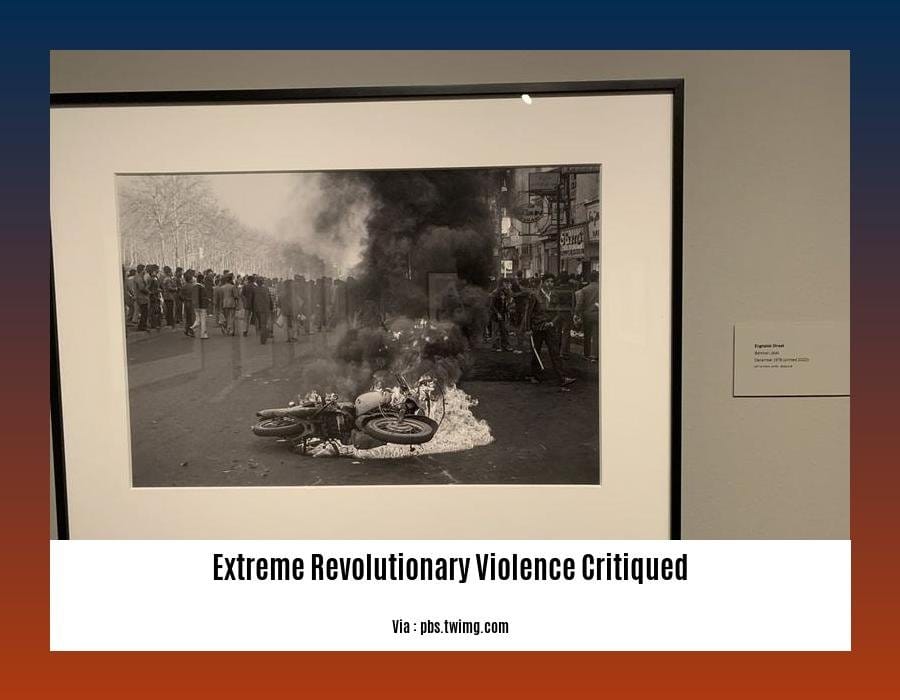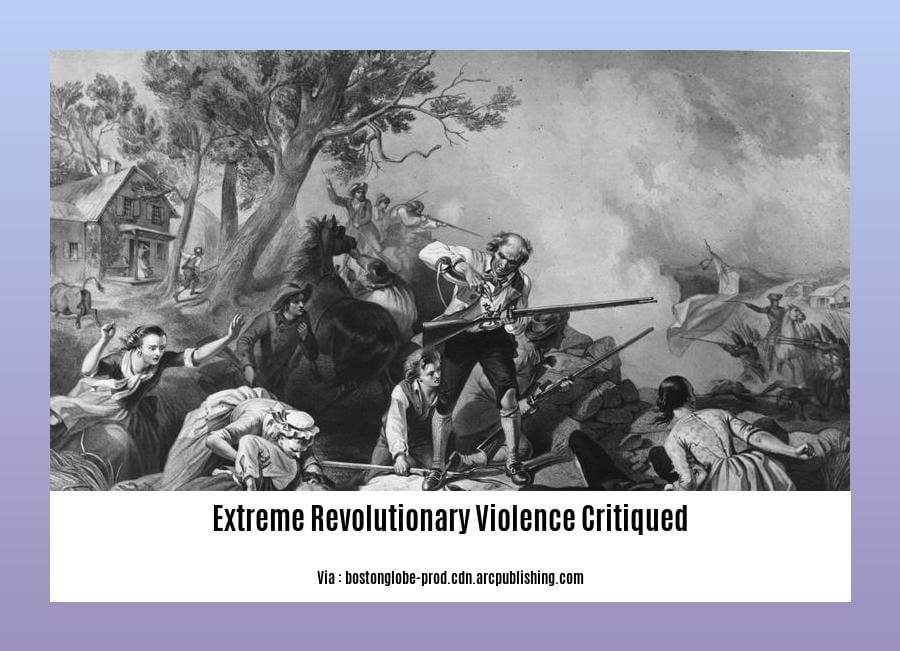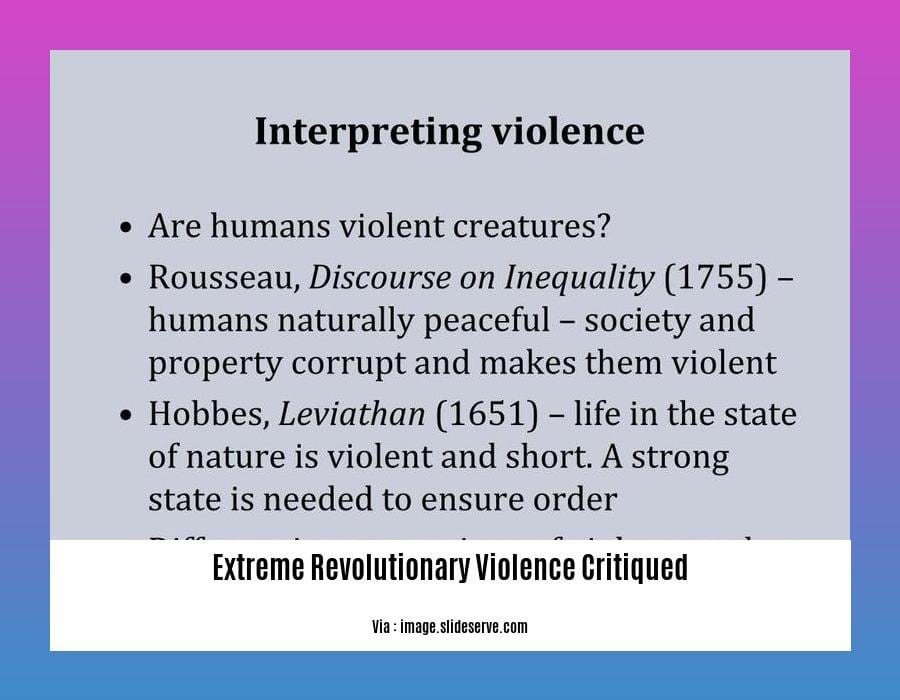Extreme Revolutionary Violence Critiqued: Causes, Consequences, and Countermeasures examines the motivations, tactics, and consequences of extreme revolutionary violence. Through expert analysis and a commitment to impartial reporting, this article illuminates the detrimental impact of these radical movements on societies, individuals, and the pursuit of legitimate political change.
Key Takeaways:

- Violence in revolutionary contexts can challenge cycles of violence and confront oppression.
- Revolutionary violence seeks to establish a society based on deep moral and social connections.
- Violent revolutions are rare and do not always lead to counterrevolutions.
- Frantz Fanon posits that revolutionary violence can facilitate liberation and societal transformation.
Extreme Revolutionary Violence Critiqued
Extreme revolutionary violence critiqued is a complex phenomenon driven by a multitude of factors. Its consequences are far-reaching, impacting societies, individuals, and aspirations for legitimate change. Understanding its causes and consequences is crucial for developing effective countermeasures.
Causes of Extreme Revolutionary Violence
- Socioeconomic Inequality: Severe economic disparities and social injustice can fuel resentment and create conditions ripe for radicalization.
- Political Oppression: Repressive regimes that deny basic freedoms, such as freedom of expression and assembly, can drive people to seek violent means of change.
- Ideological Extremism: Extreme ideologies, such as radical nationalism or religious fundamentalism, can provide a justification for violence and create a sense of superiority over others.
Consequences of Extreme Revolutionary Violence
- Humanitarian Crisis: Violent revolutions often lead to widespread suffering, including death, displacement, and human rights abuses.
- Political Instability: The collapse of existing power structures and the absence of a clear path forward can create power vacuums that fuel further violence and instability.
- Economic Devastation: Wars and conflicts destroy infrastructure, disrupt trade, and lead to a decline in economic activity.
Countermeasures to Extreme Revolutionary Violence
- Address Root Causes: Tackling socioeconomic inequality, promoting political inclusivity, and combating ideological extremism can create more stable societies less prone to violent revolution.
- Promote Dialogue and Nonviolent Resistance: Encouraging open dialogue and providing nonviolent avenues for expressing grievances can reduce the likelihood of violence as a means of change.
- Security Measures: When necessary, security measures should be employed to prevent or suppress violent acts while minimizing civilian casualties.
Conclusion
Extreme revolutionary violence critiqued is a serious threat to peace and stability. As societies face the challenges of inequality, oppression, and extremism, understanding its causes, consequences, and countermeasures is essential for preventing and mitigating its devastating effects.
The revolutionaries criticized for their violent methods resorted to violent revolutionary tactics that proved divisive.They believed in armed insurrection to achieve their political ends, leading to controversy around revolutionaries’ brutality.
Assessment of Legitimate Political Alternatives to Extremism
Extremism and political violence often stem from perceived injustice and unmet needs. To effectively combat these threats, it’s crucial to assess legitimate political alternatives to extremism. This involves understanding the grievances that drive individuals towards radicalization and providing viable solutions that address their concerns.
Key Takeaways:
– Understand the motivations behind extremist ideologies and the grievances they exploit.
– Identify existing and potential political mechanisms that can channel discontent into constructive dialogue.
– Promote nonviolent forms of resistance and encourage civic participation.
– Engage with marginalized communities to address underlying social and economic issues.
– Foster a culture of tolerance and respect for diverse perspectives.
By providing legitimate political alternatives to extremism, we empower individuals to seek change through peaceful and democratic means, contributing to more stable and resilient societies.
Most Relevant URL Source:
* Ideological Transmission in Extremism: Rethinking Counter-Extremism
Repercussions of Violence on Individuals, Societies, and Political Change
In the tumultuous realm of revolutions, violence has often been employed as a means to an end, a desperate attempt to reshape societies and seize power. While its allure lies in the promise of transformative change, its consequences can be profoundly detrimental, leaving wounds that linger long after the battles have ceased.
The Ripple Effects on the Psyche
Repercussions of Violence on Individuals:
- Trauma and psychological scars that shatter lives
- Loss of innocence, trust, and hope
- Erosion of mental health, leading to depression, anxiety, and PTSD
The Shattering of Social Fabric
Repercussions of Violence on Societies:
- Deepening societal divisions, fostering mistrust and fear
- Destruction of infrastructure, homes, and livelihoods
- Breakdown of law and order, plunging communities into chaos
The Roadblocks to Transformation
Repercussions of Violence on Political Change:
- Erosion of trust in institutions, making it harder to establish legitimate governance
- Polarization and radicalization, hindering dialogue and compromise
- Squandering of resources and energy, diverting focus from constructive solutions
The Role of Revolutionary Violence
While violence might initially serve as a catalyst for change, it ultimately undermines its own transformative potential. It creates a self-perpetuating cycle of violence and retaliation, endangering the very ideals it sought to uphold.
Key Takeaways:
- Violence has far-reaching consequences that extend beyond its immediate victims.
- The use of violent tactics in revolutions can hinder true transformation.
- The consequences of violence on individuals, societies, and political change are severe, lasting, and often irreversible.
Most Relevant URL Source:
Ayyash, M. M. (2021). Violence and Revolutionary Change. Contemporary Political Theory, 20(1), 113-132.
Promoting Nonviolent Resistance and Dialogue as Viable Alternatives
Key Takeaways:
- Nonviolent resistance is far more effective than violence in achieving political change.
- Nonviolent campaigns with widespread support, clear goals, and sound strategies are more likely to succeed.
- Nonviolence involves confronting adversaries through collective action without resorting to violence.
- Dialogue and nonviolent resistance promote greater legitimacy and stability than revolutionary violence.
Dialogue and nonviolent resistance emerge as viable alternatives to extreme revolutionary violence. History demonstrates that nonviolent civil resistance triumphs over violent force, contributing to democratic change and societal transformation.
Advantages of Nonviolent Resistance:
- Effectiveness: Nonviolent campaigns have a 10 times higher success rate in fostering democratic change compared to violent ones.
- Legitimacy: Nonviolence attracts wider support, conferring legitimacy on the movement and its objectives.
- Sustainability: Nonviolent campaigns can be sustained over extended periods, building momentum and support.
- Reduced Casualties and Devastation: Unlike violent revolutions, nonviolent resistance minimizes harm to civilians and preserves infrastructure.
- Dialogue: Nonviolence fosters inclusive dialogue, promoting understanding, reconciliation, and lasting peace.
Promoting Dialogue and Nonviolent Resistance:
- Identify Root Causes: Address the underlying socioeconomic inequalities, political grievances, or ideological extremism that fuel revolutionary violence.
- Facilitate Dialogue: Create platforms for open and constructive dialogue between conflicting parties, fostering mutual understanding and compromise.
- Promote Nonviolent Education: Educate communities about the power of nonviolent resistance, emphasizing its effectiveness, legitimacy, and moral superiority.
- Support Nonviolent Civil Society: Provide resources and support to civil society organizations engaged in nonviolent advocacy and peacebuilding efforts.
Nonviolent resistance and dialogue empower individuals and communities to effect positive change through peaceful means. By embracing these alternatives, we can mitigate the destructive consequences of revolutionary violence and usher in an era of sustainable peace and prosperity.
Most Relevant URL Source:

FAQ
Q1: Is revolutionary violence ever justified?
A1: Frantz Fanon argues that violence can be a necessary tool for liberation and societal transformation, but it must be used strategically and with a clear understanding of its potential consequences.
Q2: What are the main causes of extreme revolutionary violence?
A2: Extreme revolutionary violence often stems from a combination of factors, including political oppression, economic inequality, social injustice, and ideological extremism.
Q3: What are the most effective countermeasures against extreme revolutionary violence?
A3: Effective countermeasures include addressing the root causes of violence, promoting nonviolent resistance, strengthening democratic institutions, and fostering dialogue and reconciliation.
Q4: Is nonviolent resistance always more effective than violence?
A4: While nonviolent resistance has been shown to be more successful in creating change than violence in many cases, there is no guarantee that it will always be effective. The effectiveness of nonviolent resistance depends on factors such as the nature of the conflict, the level of support for the movement, and the resilience of the opposition.
Q5: What are the potential consequences of extreme revolutionary violence?
A5: Extreme revolutionary violence can lead to widespread suffering, loss of life, and the collapse of social order. It can also undermine legitimate political change and create a cycle of violence that is difficult to break.
- Unlock Water’s Symbolism: A Cross-Cultural Exploration - April 20, 2025
- Identify Black and White Snakes: Venomous or Harmless? - April 20, 2025
- Unlocking Potential: Origins High School’s NYC Story - April 20, 2025















